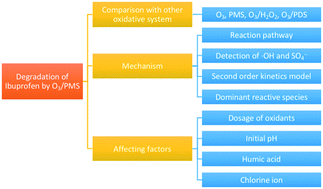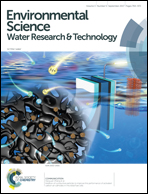Degradation of ibuprofen using ozone combined with peroxymonosulfate†
Abstract
Ozone combined with peroxymonosulfate (O3/PMS) for degradation of ibuprofen (IBP) was studied in this work. The oxidation capacity of O3/PMS and four other related oxidation processes for IBP degradation was compared. O3/PMS demonstrated a compelling degradation ability towards IBP compared with O3, PMS, O3/PDS, and O3/H2O2 processes. The generation of ˙OH and SO4˙− in O3/PMS was proved by electron spin resonance detection, and the dominant highly oxidative species was determined based on the different scavenging performances of tert-butanol and ethanol towards ˙OH and SO4˙−. The affecting factors including O3 and PMS dosage, initial pH, and organic and inorganic constituents in water were investigated. An optimum dosage of O3 and PMS was observed for degradation of IBP in O3/PMS. Though a notably synergistic effect was observed in O3/PMS for IBP degradation under pH 3.0, 5.0, 7.6 and 9.0, alkaline conditions were found to be more beneficial for IBP degradation. Humic acid, which was used to simulate the natural organic water matrix, posed different effects on O3 and O3/PMS for IBP degradation. The presence of Cl−, which is a typical reductive inorganic ion and ubiquitous in natural water, inhibited O3/PMS oxidation on the degradation of IBP. The degradation kinetics of IBP in O3/PMS was also studied in this work.



 Please wait while we load your content...
Please wait while we load your content...